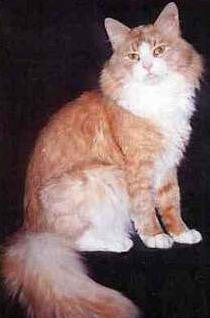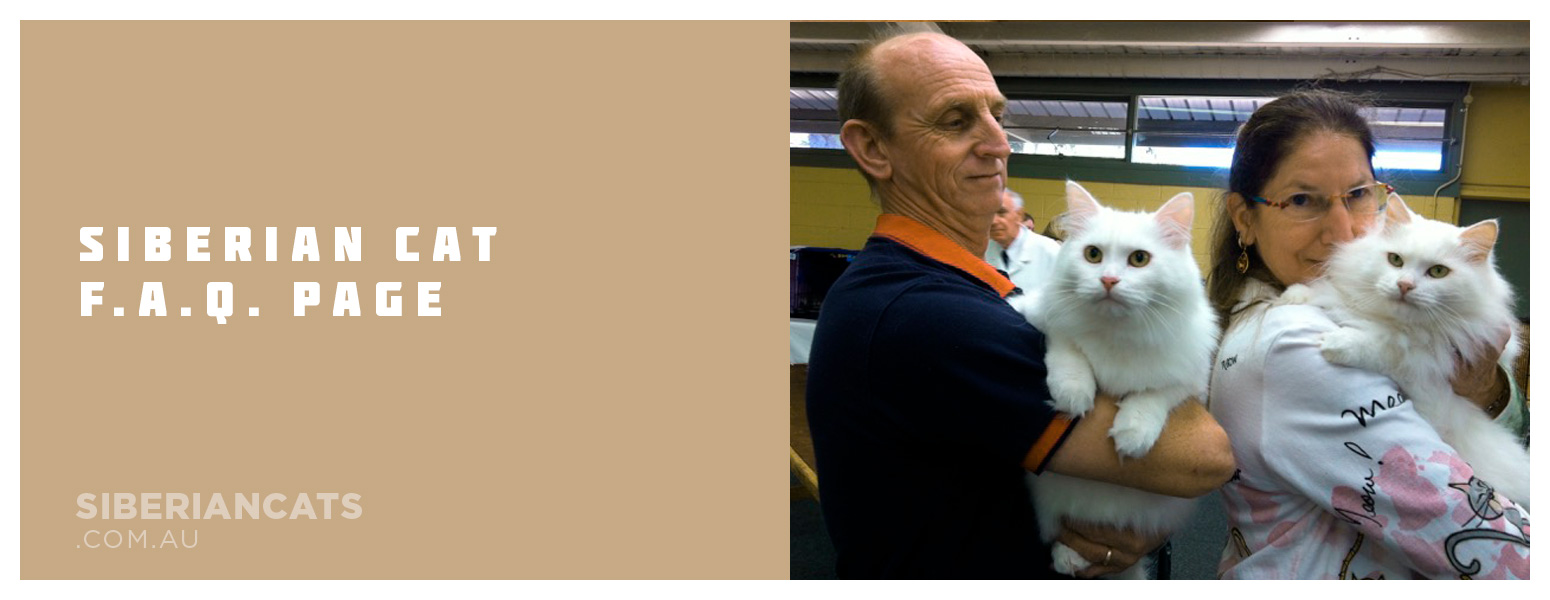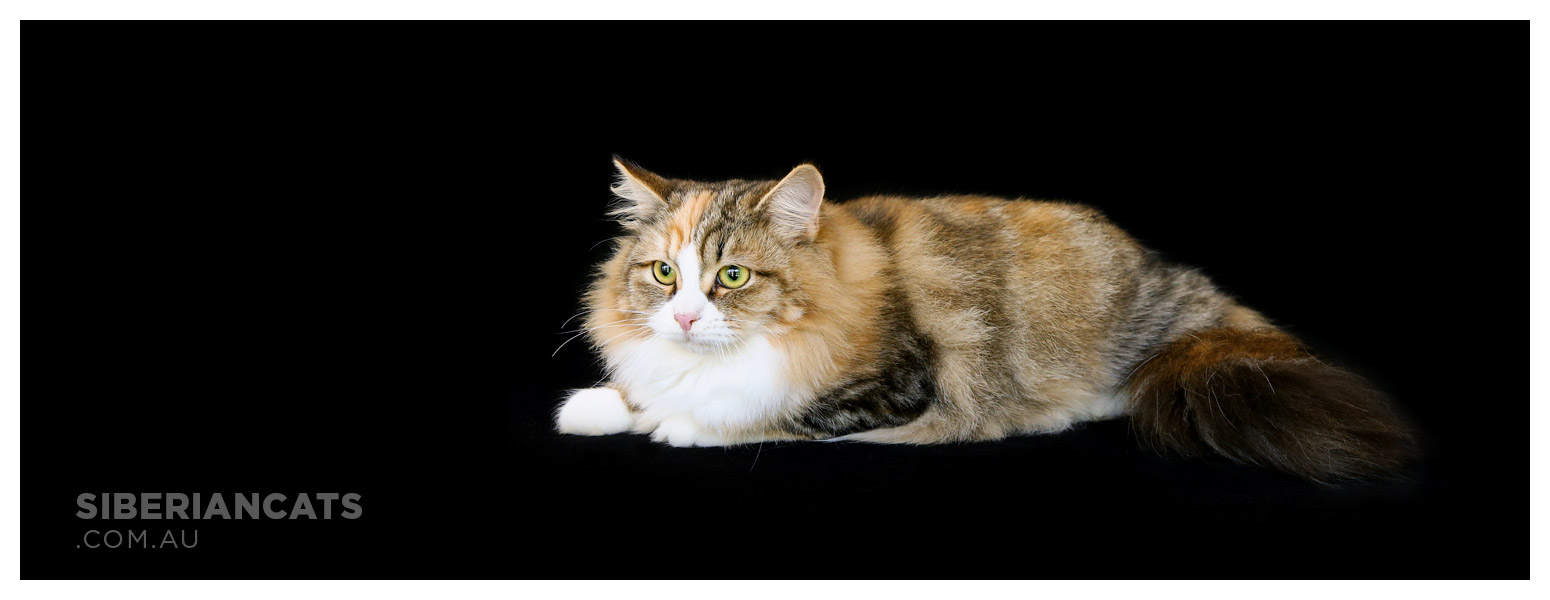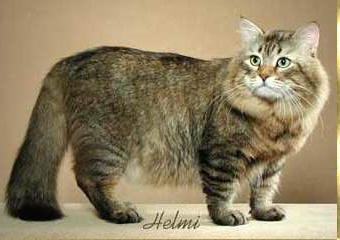The Siberian is a large, strong cat which can take up to five years to mature. The females are smaller than the males as in all breeds. They are noted for being very agile and can leap great distances. Their muscles are outstanding and powerful. The back is long and very slightly curved but appears horizontal in motion. The compact rounded belly develops with age and the hind-leg is slightly longer than the front legs, with large and powerful firm rounded paws. Their overall appearance should be a cat of great strength and size with an excellent physical tone. The facial expression is alert but sweet. The general impression of the cat is one of circles and roundness rather than angular as in some other breeds.
What are the Siberian Cat Personality Traits?
The Siberian cat has personality plus. Siberians have a very dog like temperament and are very affectionate. They come out to greet the visitors in the house and are not shy. They are very intelligent and very quick learners. They also have a triple purr and unlike other breeds have a chirping sound they use when they come to greet you. They are interested in water and may drop toys in water left in sinks to play. The Siberian makes the ideal lap cat and will live quite happily indoors with you.
Siberian Cat – The Head
The head of the Siberian is a modified wedge of medium size with rounded contours broader at the skull and narrowing slightly to a full rounded muzzle with well rounded chin. The cheek bones are neither high set or prominent there should be a good distance between the ears and the eyes. The forehead being flat and the nose has a slight curvature before the tip the neck is medium in length and round and well muscled.
Siberian Cat – Tail
The tail of the Siberian is medium in length wide at the base with a blunt tip and the end which is evenly and thickly covered with fur from the base of the tail to the tip of the tail.
Siberian Cat – Ears
The ears on the Siberian are medium to large wide and set as much on the sides of the head as on the top the tips are rounded and the ear tilts forward.
Siberian Cat – Eyes
The eyes of the Siberian are large almost round eyes set wide apart with the outer corner slightly angled toward the base of the ear. There is no relationship of eye colour to coat colour however the typical colour seen is yellow- green.
Why are the Siberian Cats “Coats” so Famous?
The coat is the Siberians crowning glory, this is a moderately to long haired coat with the fur on the lower chest and shoulder blades being slightly shorter. There should be an abundant ruff around the neck setting off the large impressive head. There is a tight undercoat, which becomes thicker in colder weather. The coat gives the impression of lacquer and oil when ungroomed. The fur on the belly and legs may thicken and curl, but this is not feature of the breed. The skin may also appear to have a bluish cast. Clear strong colours and patterns are desirable but are secondary to type.
What are the Variety of Siberian Cat Fur Colours?
Colour varieties of the Siberian vary and all colours are genetically possible, such as tabby, solid colours tortoiseshell colours silvers ab whites
What are the Origins of the Siberian Cats Colours?
There is some depute as to the origins of the colour points in the Siberian cat breed but as long as records have been kept in Russia colour points have been noted to have been produced. The Russians believe that the feral pointed cats mated with the other colours along the Neva River region in Leningrad (which is now named St Petersburg) in the 1960’s. Soon Russian breeders were including this pattern into their breeding programs and created the nick name for them “Neva-Masquerade.” Neva for the river, and masquerade, for the mask. since this was written much has come to light about the true origins of the breed
Please go to these links for background on the true origins and these two articles are written by two very high profile Russians one a breeder one the President of IFA (Rus) to which their research and knowledge is appreciated by us that live so far away from the origins of our wonderful breed
This article Siberian Cat:Without a Masquerade is included is written and researched by Alexander Kolesnikov who is a well known and respected Russian breeder of the Traditional Siberian cat and published with permission of the author.
This article Siberian race and Neva-Masquerade cat – how it was is written by Elena Shevchenko President of International Felinological Association (Russia).
In 2011/12 Fife decided to register the Neva Masquerade as a separate breed to the Siberian cat and so they are now classed as a sister breed but are not registered or allowed to interbreed with the traditional Siberian cat nor should they be called by any other name but Neva Masquerade so that the public are not confused. They are treated as two entirely different breeds and for the traditional Siberian breeders this is a win for them as they can continue to breed and hopefully in time clear out the colour pointed gene in the background of many pedigrees that many of us have unknowingly included into our breed programs.
Here at Miakoschka Siberians we do not breed colour point Neva Masquerade. We do not support any breeder that does and we will not sell to any breeder that intends to breed this colour. The breed was introduced by me to Australia intentionally without the colour point Neva Masquerade included into the breed standard for a reason apart from the fact that they are not from the same gene pool as the original Siberian but so that there would be no confusion between this cat and many of our other breeds.
Popularity of the Siberian
Between 1988 and 1990 the new breed attracted attention in other countries. Judges from the USA visiting shows in St Petersburg developed an interest in the Siberian and quite a lot of first and second generation Siberians were exported. This was the beginning of the acceptance of this breed and the basis of all of the Siberians that were bred in the USA.
The Siberian was imported into America by Mrs Elizabeth Terrell of Baton Rouge, Louisiana “Starpoint Cattery”, and David Boehm of Hackensack, New Jersey, in 1990. Mrs Terrell was a Himalayan breeder and sent some of her stock to Russia to establish the breed into Russia in exchange for some Siberians.
Mr Boehm was visiting Moscow and arranged to bring home some Siberian kittens, these were the first imports and the beginning of the breeds arrival into the United States of America. These cats were direct imports from Russia and the foundation of the Siberian cat in the USA
Siberian Cat History Originates in Moscow?

The history of the cat fancy in Russian has been controversial, there has always been cats in homes and strays in the streets, but they had only really been thought of as mouse catchers. Before 1917 there are isolated facts testifying cats being thought of as a breeding animal. There were some catteries but no breed clubs existed. In the memoirs of an old Muscovite there is an episode describing the merchants in Moscow having competitions for the cats and the fattest cat was the winner!
The Development of the Siberian Breed in Russia – The years between 1917 and the late 1980 there was a large gap. In the late 1980’s the first imported breeds appeared, these were mainly Persians and the interest in cats started to grow. The very first cat shows were held in Riga, Moscow and St Petersburg, these shows drew huge public interest. When breeders first had access to the large European shows after the lifting of the Iron Curtain they saw many other semi-long hairs and decided the new breed had to be developed and become more distinct.
Siberian Cat – Used During WWII?
During the war in 1941-1945, the city suffered a 900 day siege, and the citizens died of hunger and cold, there is no wonder there were no cats left in the city, after the siege the rats invaded the city and to fight them thousands of cats were brought in from different regions in the USSR and brought to Leningrad by train. This fact is documented and as a result cats of all possible phenotypes mixed in the streets. Thus when the cats started to breed one could find very different phenotypes.
Earlier every large fluffy cat had been called “Siberian” not because they came from Siberia the North Eastern part of Russia but because their appearance was associated with the cold and severe climate there.
In the cold humid and windy climate of St Petersburg, a large sturdy cat with a waterproof coat and dense undercoat had a better chance of surviving the climate, which is why so many of the cats of this phenotype was seen amongst the strays. One of these was the well known Roman who was used in the first description of the Siberian, and the basis of the first standard written by the President of the Kotofey club Olga Mironva and assisted by Irina Katzer.
What is the Siberian Breed Standard Chart?
| General | Size | medium to large, females mostly smaller than males |
| Head | Shape | a little bit longer than broad, softly rounded, massive |
| Forehead | broad, just slightly rounded | |
| Cheeks | cheekbones well developed, high set | |
| Nose | medium length, broad, in profile shows a slight indentation, but without stop | |
| Chin | slightly slanting back, in profile creating a curve from the upper line of the nose | |
| Ears | Shape | medium size, well open at the base, tips are rounded with well-developed hairs inside and tufts. |
| Placement | with good width between, tilting slightly forward. | |
| Eyes | Shape | large, slightly oval shaped. |
| Placement | A bit oblique, set widely apart | |
| Colour | uniform, any colour is permitted, but preference is given to green. | |
| Body | Structure | well boned and muscled, powerful neck, broad chest, body in proportion to create a rectangular appearance. |
| Legs | medium high, to form a rectangle with the body, strong | |
| Paws | large, round, well tufted between toes | |
| Tail | long, thick, rounded tip. Covered on all sides by dense hair with no hairs trailing down. | |
| Coat | Structure | semi-long, well developed, very dense, undercoat not lying flat, overcoat water repellent, slightly hard to touch. Summer coat is distinctly shorter than the winter coat. The winter coat shows a well-developed shirtfront, full frill and knickerbockers. |
| Colour | All colour varieties are permitted, including all colour varieties with white; except pointed patterns and chocolate and lilac, cinnamon and fawn.Any amount of white is allowed, i.e. a white blaze, white locket, white chest, white on the belly, white on the paws, etc. |
What About Faults?
| Faults | General | too small or too finely built |
| Head | long and narrowstraight profiletoo round head (persian type) | |
| Ears | too large ortoo high set | |
| Eyes | round eyes | |
| Legs | too long ortoo thin | |
| Tail | too short tail | |
| Coat | too fine or silkylying flatlack of coat (except in summer) |
How Does Breed Scoring Get Tallied?
| Total | 100 points | |
| Head | general shape, shape of nose, profile, chin | 25 |
| Ears | size, shape, placement | 10 |
| Eyes | shape and colour | 10 |
| Body | shape, size, legs, shape of paws | 20 |
| Tail | length and shape | 5 |
| Coat | quality, texture, length | 25 |
| Condition | 5 |
Want to know everything about Siberian Kittens?
Check out our Siberian Kittens Care FAQ page or you can learn how to Reserve a Kitten here



